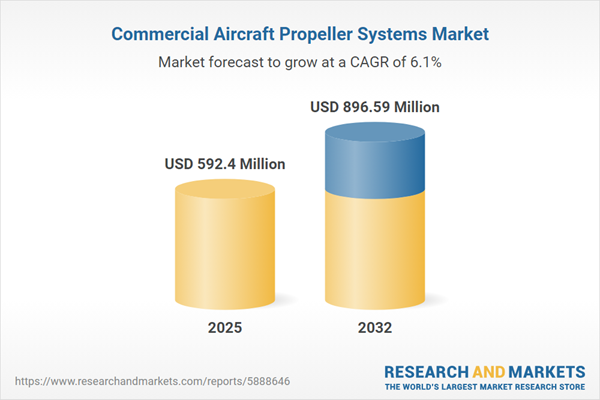Speak directly to the analyst to clarify any post sales queries you may have.
Executives navigating the commercial aircraft propeller systems market are confronting a landscape of fast-paced change, where sustainability, compliance, and efficient operations drive strategic priorities. Robust market intelligence is essential for leaders seeking clarity in investments, technology upgrades, and regulatory alignment.
Market Snapshot: Commercial Aircraft Propeller Systems
The commercial aircraft propeller systems market is realizing steady growth, shaped by the wider adoption of energy-efficient propulsion technologies and evolving industry standards. Airlines and fleet operators are focusing on modernizing fleets, with particular momentum in regional aviation. This trend responds to increasing sustainability mandates and the need for improved operational outcomes. Technological innovation and enhanced material use are redefining performance expectations, making competitive advantages reliant upon integration of advanced materials and digital systems. Organizations able to deliver both cost and environmental efficiency are emerging as industry pacesetters.
Scope & Segmentation
This commercial aircraft propeller systems market report provides actionable insight and in-depth analysis for decision-makers refining asset strategies and adapting operational plans. Segmentation aligns with diverse priorities, ensuring detailed guidance for senior leaders:
- End User: Addresses both aftermarket service and OEM deployment, highlighting strategies to optimize fleet lifecycle value and maintenance efficiency.
- Aircraft Type: Covers single- and multi-engine models, helping inform decisions about performance improvements and risk diversification in varied fleets.
- Propeller Material: Compares aluminum, composite, and wood propeller systems, evaluating implications for durability, weight, and long-term upkeep.
- Operation Type: Includes commercial, general, and military aviation requirements, clarifying sector-specific technology adoption and compliance needs.
- Number of Blades: Considers configurations ranging from two-blade to multi-blade, outlining their acoustic performance and deployment suitability by application.
- Regional Scope: Encompasses the Americas, Europe, Middle East & Africa, and Asia-Pacific, detailing regional regulatory influences and investment drivers shaping market focus.
- Leading Companies: Benchmarks organizations such as Dowty Propellers Limited, RTX Corporation, McCauley Propeller Systems, Hartzell Propeller, MT-Propeller Entwicklung, ZF Luftfahrttechnik, Sensenich Propeller, Hoffmann Propeller-Technik, Airmaster Propeller Systems, and Avia Propeller to map competitive dynamics across the sector.
- Technological Developments: Reviews advances including broader composite adoption for weight reduction and smarter, digital tools that support proactive fleet monitoring and compliance across regulatory environments.
Key Takeaways for Executive Leadership
- Integrating composite materials and digital control solutions boosts operational agility and underpins programs for modernizing regional and global fleets.
- Recent breakthroughs in propeller and turboprop engineering are allowing airlines to expand network options while aligning with sustainability objectives and disciplined cost strategies.
- Leaders are advancing product reliability and regulatory agility by anticipating and adapting to shifting certification standards unique to each region.
- Investments in predictive maintenance and robust aftermarket support enhance aircraft availability and maximize the lifetime value of assets across diversified fleets.
- Forging strong partnerships with OEMs and technology suppliers reinforces supply chain resilience, reducing volatility exposure amid global economic fluctuations.
- Custom blade configurations designed for emerging noise standards provide precise responses to evolving regulatory and operational demands, especially in regions with stringent noise compliance.
Tariff Impact on Supply Chain Economics
Recent updates to U.S. tariffs have significantly reshaped supply chain dynamics for commercial aircraft propeller systems. Manufacturers are addressing these challenges by diversifying sourcing, expanding domestic production capabilities, and deepening their supplier networks. Procurement and operations leaders are leveraging risk management practices and adaptive planning, bolstering stability as market and trade regulations evolve.
Methodology & Data Sources
The report synthesizes executive interviews, in-depth proprietary data from suppliers and service providers, and validated third-party survey results. This combined methodology delivers actionable, strategic insight and a realistic view of the commercial aircraft propeller systems market, supporting confident decision-making during industry shifts.
Why This Report Matters
- Enables executive teams to synchronize operations and investment with the latest industry best practices and regulatory requirements.
- Fosters organizational agility by equipping leaders to manage supply chain and regulatory shifts with resilience and foresight.
- Supports effective adoption of advanced technology and supplier relationships to maintain operational excellence and address ongoing market evolution.
Conclusion
This analysis equips senior executives with the market intelligence and strategic guidance necessary to drive process improvement, strengthen market adaptability, and support sustainable growth in the commercial aircraft propeller systems industry.
Additional Product Information:
- Purchase of this report includes 1 year online access with quarterly updates.
- This report can be updated on request. Please contact our Customer Experience team using the Ask a Question widget on our website.
Table of Contents
3. Executive Summary
4. Market Overview
7. Cumulative Impact of Artificial Intelligence 2025
Companies Mentioned
The companies profiled in this Commercial Aircraft Propeller Systems market report include:- Dowty Propellers Limited
- RTX Corporation
- McCauley Propeller Systems, Inc.
- Hartzell Propeller Inc.
- MT-Propeller Entwicklung GmbH & Co. KG
- ZF Luftfahrttechnik GmbH
- Sensenich Propeller Company
- Hoffmann GmbH Propeller-Technik
- Airmaster Propeller Systems, Inc.
- Avia Propeller s.r.o.
Table Information
| Report Attribute | Details |
|---|---|
| No. of Pages | 193 |
| Published | November 2025 |
| Forecast Period | 2025 - 2032 |
| Estimated Market Value ( USD | $ 592.4 Million |
| Forecasted Market Value ( USD | $ 896.59 Million |
| Compound Annual Growth Rate | 6.0% |
| Regions Covered | Global |
| No. of Companies Mentioned | 11 |









